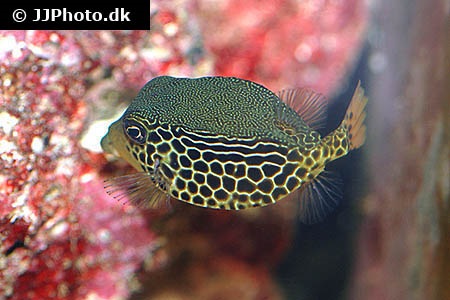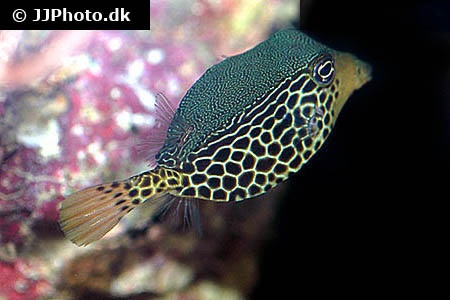Ostracion solorensis


| Latin name | Ostracion solorensis - Bleeker, 1853 |
|---|---|
| Local name | Reticulate boxfish |
| Family | Ostraciidae - Ostracion |
| Origin | Australia, Indonesia, Central/West Pacific |
| Max length | 12 cm (4.7") |
| Minimum volume |
700 l (185 gal) |
|---|---|
| Hardiness |
Average |
| Suitable for aquarium |
Suitable with care |
| Reef safe |
Unknown |
| Aggressiveness | Docile |
There is little available knowledge of this species, so there can be important information missing on this page.
This species has a toxin in its skin, which it releases when highly stressed or dying.
This poison can kill all the aquatic life in the aquarium, if unlucky.
There is a greater chance of success with this species if one can supply a living feed to allow it to adapt to the tank.
This species cannot maneuver in strong currents, especially so when small.
Pay particular attention to the pump’s water inlet as these fish in certain circumstances, can get stuck.
This species often has a fun and interesting personality.
This species is very shy and docile, so one should be careful when keeping it with more aggressive fish.
Is light in colour when young and gradually becomes darker.
Boxfish(Ostraciidae) have a unique square shape and a particular way of swimming.
They have a rather special personality, which one quickly comes to love.
Boxfish live typically off a mixture of algae, coral polyps, zooplankton, and in some cases crustaceans.
They are not normally reef safe and when small will require gentle water circulation.
Boxfish can secrete a poison when stressed or if they die, which can in the worst case, kill the contents of a whole aquarium.
Never use the water the fish was transported in.
| Aquarium trade | Yes |
|---|---|
| Distribution | Western Pacific: Christmas Island in the eastern Indian Ocean and Indonesia to Fiji, north to the Philippines. Recently recorded from Tonga (Ref. 53797) and the northern northern Great Barrier Reef (Ref. 9710). |
| English common names |
Solor boxfish Reticulate boxfish Reticulated boxfish |
Bob Fenner. The Puffers Called Box-, Cowfishes, family Ostraciidae - Wet Web Media - (English)
Richard Aspinall. 2012. Oddballs for the Marine Aquarium - Tropical Fish Hobbyist - (English)

